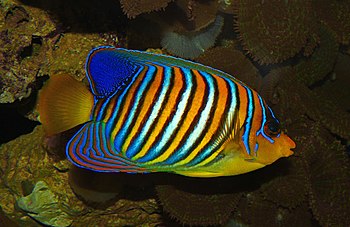 |
| Pygoplites diacanthus, Pomacanthidae, Royal Angelfish (Photo credit: Wikipedia) |
Its scientific designation given to this beauty is Pygoplites Diacanthus. Currently, it's the lone member of the genus Pygoplites. The regal angelfish has an extensive intense yellow main body including vertical white streaks that are outlined by blue.
Similar to all members of the large angel family, juveniles wear a noticeably unusual coloration pattern than adults. Young specimens do not have blue coloration and are commonly seen bearing yellow along with white with a distinctive spot close to the tail.
They are acknowledged to better a foot in length in the wild. In the aquarium, however, they usually attain a maximum length of roughly twelve inches.
They are generally found all over the Indo-Pacific, Fiji, and various areas in Africa. Fishes collected from the Philippines as well as Indonesia do not fare very well in captivity and normally have an excessive death percentage. This might have something to do with collection methods.
In their natural habitats, these fish are grazers that feed solely on tunicates and sponges. This really is the chief reason why Regal Angelfish typically do badly in captivity. They may be tricky eaters that usually starve to death over a length of time. They must be offered a great mixture of seafood, saltwater seaweed strips and in particular sponges daily if possible.
Always quarantine your fishes to make certain they are disease and parasite free. Sometimes you may well come upon two-inch juveniles for sale at the saltwater store. Resist the urge to purchase them if you do not have a large enough saltwater tank. The regal angelfish is the most beautiful and highly regarded large angelfish by enthusiasts. Alas, their high mortality percentage in captivity does put off a lot of hobbyists.
|

No comments:
Post a Comment